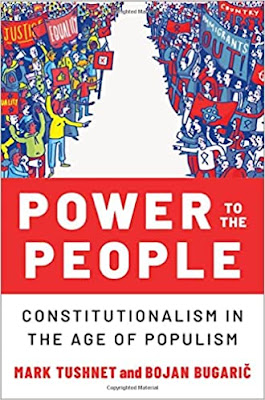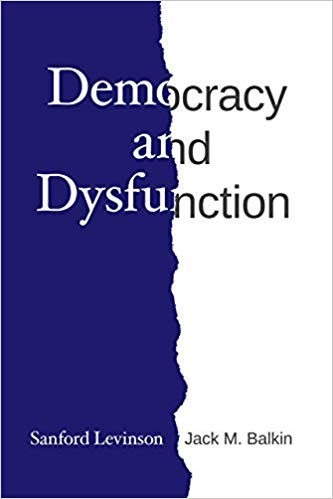Balkinization
an unanticipated consequence of
Jack M. Balkin
Balkinization Symposiums: A Continuing List
E-mail:
Jack Balkin:
jackbalkin at yahoo.com
Bruce Ackerman
bruce.ackerman at yale.edu
Ian Ayres
ian.ayres at yale.edu
Corey Brettschneider
corey_brettschneider at brown.edu
Mary Dudziak
mary.l.dudziak at emory.edu
Joey Fishkin
joey.fishkin at gmail.com
Heather Gerken heather.gerken at yale.edu
Abbe Gluck abbe.gluck at yale.edu
Mark Graber
mgraber at law.umaryland.edu
Stephen Griffin
sgriffin at tulane.edu
Jonathan Hafetz
jonathan.hafetz at shu.edu
Jeremy Kessler
jkessler at law.columbia.edu
Andrew Koppelman
akoppelman at law.northwestern.edu
Marty Lederman
msl46 at law.georgetown.edu
Sanford Levinson
slevinson at law.utexas.edu
David Luban
david.luban at gmail.com
Gerard Magliocca
gmaglioc at iupui.edu
Jason Mazzone
mazzonej at illinois.edu
Linda McClain
lmcclain at bu.edu
John Mikhail
mikhail at law.georgetown.edu
Frank Pasquale
pasquale.frank at gmail.com
Nate Persily
npersily at gmail.com
Michael Stokes Paulsen
michaelstokespaulsen at gmail.com
Deborah Pearlstein
dpearlst at yu.edu
Rick Pildes
rick.pildes at nyu.edu
David Pozen
dpozen at law.columbia.edu
Richard Primus
raprimus at umich.edu
K. Sabeel Rahmansabeel.rahman at brooklaw.edu
Alice Ristroph
alice.ristroph at shu.edu
Neil Siegel
siegel at law.duke.edu
David Super
david.super at law.georgetown.edu
Brian Tamanaha
btamanaha at wulaw.wustl.edu
Nelson Tebbe
nelson.tebbe at brooklaw.edu
Mark Tushnet
mtushnet at law.harvard.edu
Adam Winkler
winkler at ucla.edu
Compendium of posts on Hobby Lobby and related cases
The Anti-Torture Memos: Balkinization Posts on Torture, Interrogation, Detention, War Powers, and OLC
The Anti-Torture Memos (arranged by topic)
Recent Posts
Short Circuited Surge Capacity: Lessons from the Blizzard for Public Health
Just A Few Blogs
ACS Blog
Alas, a Blog
Althouse
Arts and Letters Daily
Atrios (Eschaton)
Bill of Health
Buzzflash.com
Buzz Machine
Cato at Liberty
Juan Cole (Informed Comment)
Concurring Opinions
The Constitution in 2020
Corrente
Crooked Timber
Daily Howler
Daily Kos
Dana Boyd
Brad DeLong
Digby (Hullabaloo)
Discriminations
Daniel Drezner
Kevin Drum (Mother Jones)
Electrolite
En Banc
Eunomia (Daniel Larison)
Fafblog
Michael Froomkin (Discourse.net)
GovLab (Beth Noveck)
Rick Hasen (Election Law)
History News Network
How Appealing
Ignatz (Sam Heldman)
The Importance of (Ernie Miller)
Infolaw
Instapundit
International Economic Law and Policy Blog
IntLawGrrls
Jacob Levy
Jesus' General
Jurisdynamics
The Kitchen Cabinet
Mark Kleiman
Law Blog Central
Larry Lessig
Lawyers, Guns and Money
Liberal Oasis
Brian Leiter's Law School Reports
The Leiter Reports
Marginal Revolution
Megan McArdle
Memeorandum
Metafilter
Mirror of Justice
The New Republic
Newseum
No More Mister Nice Blog
Brendan Nyhan
Opinio Juris
Orcinus
The Originalism Blog
Pandagon
Passport (Foreign Policy)
Overcoming Bias
Political Animal (Washington Monthly)
Political Theory Daily Review
Political Wire (Taegan Goddard)
The Poor Man
Virginia Postrel
Prawfsblawg
Public Reason
Jonathan Rauch
Raw Story
Redstate
ReligiousLeftLaw.com
Reporters Committee For Freedom of the Press
Reproductive Rights Blog
Rothman's Roadmap to the Right of Publicity
SCOTUS Blog
Seeing the Forest
Clay Shirky
The Shifted Librarian
The Situationist
Larry Solum (Legal Theory)
Andrew Sullivan
Talking Points Memo
Talk Left
Tapped
Tbogg
TechPresident
The Paper Chase (Jurist)
Tom Paine
Tom Tomorrow (This Modern World)
Eve Tushnet
Uggabugga
University of Chicago Law School Faculty Blog
Unqualified Offerings
The Volokh Conspiracy
War and Piece (Laura Rozen)
Wampum
Oliver Willis
Wonkette
Written Description
Matthew Yglesias
Yin
Your Choice of Feeds
1. XML
powered by
2. Atom Feed
3. RSS 2.0
Tuesday, December 28, 2010
Short Circuited Surge Capacity: Lessons from the Blizzard for Public Health
Frank Pasquale
Bad weather recently caused massive failures at Heathrow Airport, and brought chaos to air travel in the New York area. Both scenarios suggest an intriguing set of dilemmas in health law and policy. We should be doing much more to prepare for sudden, disruptive events in both the transportation and health sectors. But economic short-termism rules the roost, undercutting the infrastructural investments that a more enlightened America would make.
Stuart Altman wisely compared hospitals and airlines in 2006, and worried that many of the former would suffer the fate of legacy carriers: By 2025 the need for general hospitals to cross-subsidize [i.e., use payments from the well-insured to pay for others' care] will greatly increase, but their ability to do so will be diminished. U.S. hospitals could begin to resemble U.S. airlines: severely cutting costs, eliminating services, and suffering financial instability. . . .
There are numerous similarities between the airline and hospital industries. Both comprise companies that built a complex infrastructure and provided cross-subsidized services. Both were protected by a lack of price transparency and limited competition. In the recently deregulated airline industry, price competition and specialized airlines have emerged that do not have to serve all cities and can focus on the most profitable routes. They need not charge higher prices for these routes to make up for losses incurred elsewhere. Similarly, in the hospital industry, specialty hospitals have emerged that can focus on the most profitable patients and do not have to treat the uninsured or provide money-losing services.
The new specialty hospitals, like the new low-cost carriers, are not saddled with fixed costs from old plant and equipment and do not have to contend with excess capacity that resulted from historical changes in demand.* Both use their inherent cost advantages to compete for more price-sensitive consumers. Legacy airlines cannot raise fares to cover costs because price-sensitive customers can now obtain transparent price information on the Internet and shop for the lowest fares. California is now requiring, and many advocacy organizations are encouraging, hospitals to post their prices on the Internet. Hospital patients, facing increased copayments, deductibles, and other out-of-pocket costs, could begin to behave more like airline passengers. . . .
Because of increased price transparency and specialized competition, legacy airlines could not raise prices sufficiently to cover their costs. Between 1 October 2001 and 31 December 2003, they cut costs by $12.1 billion. They stopped serving some locales and reduced seat capacity. They cut labor costs, services, and amenities. Nevertheless, from 2001 through 2003, the legacy airlines lost $24.3 billion, while the low-cost carriers reported profits of $1.3 billion.
The past few years have witnessed a recovery for many airlines pushed to the brink after 9/11. They filled more seats in each plane (leading to higher "load factors") and otherwise "cut the fat" (sometimes endangering passengers in the process). Nate Silver observes that filling up planes has some positive effects on prices and the environment, but also sets in motion dynamics that few fully consider until the unexpected strikes: [L]oad factors have been rising steadily. A decade ago, they were closer to 70 percent, which permitted quite a bit more slack in the event of cancellations. At a 70 percent load factor, there are 2.3 passengers for every available seat, which means, roughly speaking, that one day’s worth of cancellations might take two days to clear through the system. At an 82 percent load factor, on the other hand, there are 4.6 passengers for every seat — roughly twice as many — so one day’s worth of cancellations might require four or five days to get everyone home.
The societal trade-offs here are tough, and airlines need flexibility in determining how far they should go to crowd planes and maximize profits. But in the realm of healthcare, I am much more concerned that a long series of hospital closures will leave the system disastrously overwhelmed in case of an infectious disease outbreak, terrorist attack, or extreme weather event. Like airlines, hospitals have been cutting their surge capacity in order to improve the bottom line. As I noted over four years ago, the asymmetry between projected demand and supply for something as fundamental as ventilators is shocking. A 2006 estimate suggested that only 5,000 spare ventilators would be available to as many as 742,500 people in need in the case of a serious pandemic.
In a 2005 article in the Journal of Contemporary Health Law and Policy, Lance Gable et al. discuss surge capacity as “the number of critical casualties arriving per unit of time that can be managed without compromising the level of care,” and propose ways of increasing "the availability of skilled health professionals to supplement the existing health workforce." I applaud their approach and attention to the problem (astonishingly, it is the only article in the Westlaw JLR database with "surge capacity" in the title). But I also worry that scarce physical space is going to cause as large a problem at hospitals as personnel shortages. Like its airports, New York's community hospitals are fraying: In New York’s many community hospitals, which provide an essential first line of defense in the effort to safeguard public health, the danger of failure is particularly acute. Combine growing costs, decreasing revenues, and high debt loads, and you can’t dig out. Then what happens? “If you’ve accumulated any reserve over time,” an executive at a major local hospital says, “the first thing you do is eat it up. Then you cut costs on staffing and support services, sometimes below levels you know are safe. Then you stop spending money to keep your physical plant and equipment up to date. The condition of the physical plants of many New York City hospitals is staggering. Then, when there’s nothing else you can do, you declare bankruptcy. That’s the life cycle of a New York hospital.”
Given all these strains, hospitals may have to choose between community service and solvency in the wake of a major outbreak of illness. Vickie J. Williams's article "Fluconomics" presciently examined the bad financial incentives that hospitals would face in case of a serious outbreak of infectious disease: [W]e currently have no means of ensuring that hospitals acting as isolation, quarantine, and treatment centers in a pandemic will survive the loss of revenue that they will experience in protecting the public's health. Our hospitals depend on a fragmented financing system that presumes the hospital's ability to shift costs from low-paying public payors to higher-paying private payors, and from less lucrative cases to more lucrative, often elective, procedures.
During a pandemic, hospitals treating pandemic victims will be unable to perform this cost-shifting function. Furthermore, the stigma that surrounds a hospital that acts as an isolation or quarantine center for an infectious disease will make it difficult for such hospitals to attract privately insured patients for some time after a pandemic ceases. The failure to provide financial assurances to hospitals and other first responders to a pandemic is likely to result in severe damage to our hospital system and to our ability to care for the sick and injured, both during and after a pandemic.
Hospitals, airlines, and airports face far too many incentives to capture immediate profits rather than to prepare for truly trying events. Conservatives constantly urge individuals to save---why can't their potent political movement also encourage critical institutions to invest in resilience? Aviation expert Clive Irving explains that Heathrow could be paralyzed by 5 inches of snow because "it’s more concerned with being a mall than plowing runways." Similarly, I believe that both the American and global health care systems are too consumed with profit centers like boutique medicine and cosmetic surgery. In a "Third World America," critical infrastructure is all too often left at risk as its ostensible stewards seek short-term gain.
As socioeconomic systems become more complex, we should redouble our investments in their resiliency. Instead, our political leaders appear to be giving up on husbanding resources to prepare for the worst. Stranded travelers, abandoned cars, and unplowed streets in all but New York's richest borough are bellwethers for more serious infrastructural breakdowns in the future.
*Altman's article was written before passage of the Affordable Care Act. PPACA "established a permanent moratorium on the creation or expansion of new physician-owned hospitals after December 31, 2010" but grandfathered in existing ones.
X-Posted: Health Reform Watch.
Posted
5:53 PM
by Frank Pasquale [link]
Books by Balkinization Bloggers

Gerard N. Magliocca, The Actual Art of Governing: Justice Robert H. Jackson's Concurring Opinion in the Steel Seizure Case (Oxford University Press, 2025)

Linda C. McClain and Aziza Ahmed, The Routledge Companion to Gender and COVID-19 (Routledge, 2024)

David Pozen, The Constitution of the War on Drugs (Oxford University Press, 2024)

Jack M. Balkin, Memory and Authority: The Uses of History in Constitutional Interpretation (Yale University Press, 2024)

Mark A. Graber, Punish Treason, Reward Loyalty: The Forgotten Goals of Constitutional Reform after the Civil War (University of Kansas Press, 2023)

Jack M. Balkin, What Roe v. Wade Should Have Said: The Nation's Top Legal Experts Rewrite America's Most Controversial Decision - Revised Edition (NYU Press, 2023)

Andrew Koppelman, Burning Down the House: How Libertarian Philosophy Was Corrupted by Delusion and Greed (St. Martin’s Press, 2022)

Gerard N. Magliocca, Washington's Heir: The Life of Justice Bushrod Washington (Oxford University Press, 2022)

Joseph Fishkin and William E. Forbath, The Anti-Oligarchy Constitution: Reconstructing the Economic Foundations of American Democracy (Harvard University Press, 2022)

Mark Tushnet and Bojan Bugaric, Power to the People: Constitutionalism in the Age of Populism (Oxford University Press 2021).

Mark Philip Bradley and Mary L. Dudziak, eds., Making the Forever War: Marilyn B. Young on the Culture and Politics of American Militarism Culture and Politics in the Cold War and Beyond (University of Massachusetts Press, 2021).

Jack M. Balkin, What Obergefell v. Hodges Should Have Said: The Nation's Top Legal Experts Rewrite America's Same-Sex Marriage Decision (Yale University Press, 2020)

Frank Pasquale, New Laws of Robotics: Defending Human Expertise in the Age of AI (Belknap Press, 2020)

Jack M. Balkin, The Cycles of Constitutional Time (Oxford University Press, 2020)

Mark Tushnet, Taking Back the Constitution: Activist Judges and the Next Age of American Law (Yale University Press 2020).

Andrew Koppelman, Gay Rights vs. Religious Liberty?: The Unnecessary Conflict (Oxford University Press, 2020)

Ezekiel J Emanuel and Abbe R. Gluck, The Trillion Dollar Revolution: How the Affordable Care Act Transformed Politics, Law, and Health Care in America (PublicAffairs, 2020)

Linda C. McClain, Who's the Bigot?: Learning from Conflicts over Marriage and Civil Rights Law (Oxford University Press, 2020)

Sanford Levinson and Jack M. Balkin, Democracy and Dysfunction (University of Chicago Press, 2019)

Sanford Levinson, Written in Stone: Public Monuments in Changing Societies (Duke University Press 2018)

Mark A. Graber, Sanford Levinson, and Mark Tushnet, eds., Constitutional Democracy in Crisis? (Oxford University Press 2018)

Gerard Magliocca, The Heart of the Constitution: How the Bill of Rights became the Bill of Rights (Oxford University Press, 2018)

Cynthia Levinson and Sanford Levinson, Fault Lines in the Constitution: The Framers, Their Fights, and the Flaws that Affect Us Today (Peachtree Publishers, 2017)

Brian Z. Tamanaha, A Realistic Theory of Law (Cambridge University Press 2017)

Sanford Levinson, Nullification and Secession in Modern Constitutional Thought (University Press of Kansas 2016)

Sanford Levinson, An Argument Open to All: Reading The Federalist in the 21st Century (Yale University Press 2015)

Stephen M. Griffin, Broken Trust: Dysfunctional Government and Constitutional Reform (University Press of Kansas, 2015)

Frank Pasquale, The Black Box Society: The Secret Algorithms That Control Money and Information (Harvard University Press, 2015)

Bruce Ackerman, We the People, Volume 3: The Civil Rights Revolution (Harvard University Press, 2014)
Balkinization Symposium on We the People, Volume 3: The Civil Rights Revolution

Joseph Fishkin, Bottlenecks: A New Theory of Equal Opportunity (Oxford University Press, 2014)

Mark A. Graber, A New Introduction to American Constitutionalism (Oxford University Press, 2013)

John Mikhail, Elements of Moral Cognition: Rawls' Linguistic Analogy and the Cognitive Science of Moral and Legal Judgment (Cambridge University Press, 2013)

Gerard N. Magliocca, American Founding Son: John Bingham and the Invention of the Fourteenth Amendment (New York University Press, 2013)

Stephen M. Griffin, Long Wars and the Constitution (Harvard University Press, 2013)

Andrew Koppelman, The Tough Luck Constitution and the Assault on Health Care Reform (Oxford University Press, 2013)

James E. Fleming and Linda C. McClain, Ordered Liberty: Rights, Responsibilities, and Virtues (Harvard University Press, 2013)
Balkinization Symposium on Ordered Liberty: Rights, Responsibilities, and Virtues

Andrew Koppelman, Defending American Religious Neutrality (Harvard University Press, 2013)

Brian Z. Tamanaha, Failing Law Schools (University of Chicago Press, 2012)

Sanford Levinson, Framed: America's 51 Constitutions and the Crisis of Governance (Oxford University Press, 2012)

Linda C. McClain and Joanna L. Grossman, Gender Equality: Dimensions of Women's Equal Citizenship (Cambridge University Press, 2012)

Mary Dudziak, War Time: An Idea, Its History, Its Consequences (Oxford University Press, 2012)

Jack M. Balkin, Living Originalism (Harvard University Press, 2011)

Jason Mazzone, Copyfraud and Other Abuses of Intellectual Property Law (Stanford University Press, 2011)

Richard W. Garnett and Andrew Koppelman, First Amendment Stories, (Foundation Press 2011)

Jack M. Balkin, Constitutional Redemption: Political Faith in an Unjust World (Harvard University Press, 2011)

Gerard Magliocca, The Tragedy of William Jennings Bryan: Constitutional Law and the Politics of Backlash (Yale University Press, 2011)

Bernard Harcourt, The Illusion of Free Markets: Punishment and the Myth of Natural Order (Harvard University Press, 2010)

Bruce Ackerman, The Decline and Fall of the American Republic (Harvard University Press, 2010)
Balkinization Symposium on The Decline and Fall of the American Republic

Ian Ayres. Carrots and Sticks: Unlock the Power of Incentives to Get Things Done (Bantam Books, 2010)

Mark Tushnet, Why the Constitution Matters (Yale University Press 2010)
Ian Ayres and Barry Nalebuff: Lifecycle Investing: A New, Safe, and Audacious Way to Improve the Performance of Your Retirement Portfolio (Basic Books, 2010)
.jpg)
Jack M. Balkin, The Laws of Change: I Ching and the Philosophy of Life (2d Edition, Sybil Creek Press 2009)

Brian Z. Tamanaha, Beyond the Formalist-Realist Divide: The Role of Politics in Judging (Princeton University Press 2009)

Andrew Koppelman and Tobias Barrington Wolff, A Right to Discriminate?: How the Case of Boy Scouts of America v. James Dale Warped the Law of Free Association (Yale University Press 2009)

Jack M. Balkin and Reva B. Siegel, The Constitution in 2020 (Oxford University Press 2009)
Heather K. Gerken, The Democracy Index: Why Our Election System Is Failing and How to Fix It (Princeton University Press 2009)

Mary Dudziak, Exporting American Dreams: Thurgood Marshall's African Journey (Oxford University Press 2008)

David Luban, Legal Ethics and Human Dignity (Cambridge Univ. Press 2007)

Ian Ayres, Super Crunchers: Why Thinking-By-Numbers is the New Way to be Smart (Bantam 2007)

Jack M. Balkin, James Grimmelmann, Eddan Katz, Nimrod Kozlovski, Shlomit Wagman and Tal Zarsky, eds., Cybercrime: Digital Cops in a Networked Environment (N.Y.U. Press 2007)

Jack M. Balkin and Beth Simone Noveck, The State of Play: Law, Games, and Virtual Worlds (N.Y.U. Press 2006)

Andrew Koppelman, Same Sex, Different States: When Same-Sex Marriages Cross State Lines (Yale University Press 2006)
Brian Tamanaha, Law as a Means to an End (Cambridge University Press 2006)
Sanford Levinson, Our Undemocratic Constitution (Oxford University Press 2006)
Mark Graber, Dred Scott and the Problem of Constitutional Evil (Cambridge University Press 2006)
Jack M. Balkin, ed., What Roe v. Wade Should Have Said (N.Y.U. Press 2005)
Sanford Levinson, ed., Torture: A Collection (Oxford University Press 2004)
Balkin.com homepage
Bibliography
Conlaw.net
Cultural Software
Writings
Opeds
The Information Society Project
BrownvBoard.com
Useful Links
Syllabi and Exams